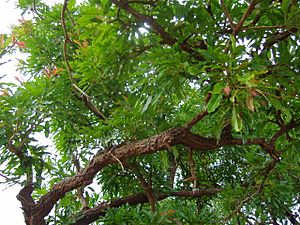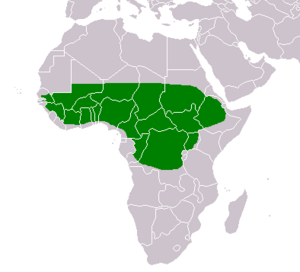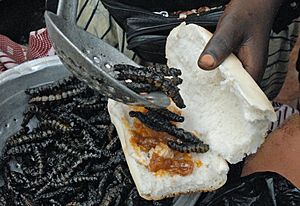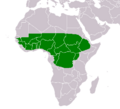Vitellaria facts for kids
Quick facts for kids Vitellaria |
|
|---|---|
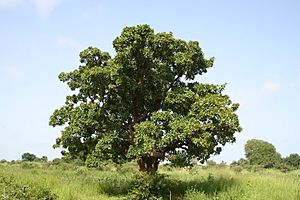 |
|
| Shea tree | |
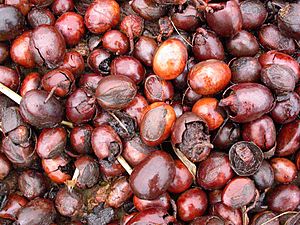 |
|
| Shea nuts | |
| Conservation status | |
| Scientific classification | |
| Genus: |
Vitellaria
|
| Species: |
paradoxa
|
| Synonyms | |
|
Butyrospermum paradoxa |
|
The shea tree (scientific name: Vitellaria paradoxa) is a special tree found only in Africa. It used to be called Butyrospermum parkii. This tree belongs to the Sapotaceae family. It's the only type of tree in its group, called Vitellaria.
The shea fruit has a thin, slightly sour, but healthy pulp. Inside, there's a large seed full of oil. This oil is used to make shea butter. Shea trees usually grow to be 7 to 15 meters (23-49 feet) tall. Some can even reach 25 meters (82 feet) with a thick trunk.
The shea tree is a very important food plant in Africa. People believe it can help improve nutrition and provide food, especially during the "hungry season" when other foods are scarce. It also helps local communities grow and supports healthy land.
Contents
Life Cycle of the Shea Tree
Shea trees start growing their first fruits when they are 10 to 15 years old. They produce a lot of nuts when they are about 20 to 30 years old. Once they start, these amazing trees can keep producing nuts for up to 200 years!
The fruits look like big plums. They are about 4 to 8 centimeters long and weigh between 10 and 57 grams each. It takes 4 to 6 months for the fruits to ripen. On average, one tree can produce 15 to 20 kilograms (33-44 lbs.) of fresh fruit. Some trees can even give up to 45 kilograms (99 lbs.)! From one kilogram of fruit, you can get about 400 grams (14 oz.) of dry seeds.
What is Shea Butter Made Of?
Shea butter is mostly made of five main types of fats. About 85% to 90% of these fats are called stearic and oleic acids. These two fats decide how soft or hard the shea butter will be. Stearic acid makes it solid, while oleic acid makes it softer, depending on how warm it is.
The amount of these fats can be different depending on where the shea tree grows. For example, shea butter from Uganda has a lot of oleic acid, so it's often liquid in warm weather. It can even separate into liquid and solid parts. Shea butter from West Africa can vary a lot more in its softness. Even trees growing next to each other can produce different types of butter!
When people make shea butter locally, they gather nuts from many trees. This means the final shea butter will have an average softness from all those nuts. In West Africa, shea butter from the Mossi Plateau in Burkina Faso usually has more stearic acid, making it harder than shea butter from other areas.
Healthy Stuff in Shea Butter
Shea butter also contains special compounds called phenolics. These are known to have antioxidant properties, which means they can help protect your body's cells. Scientists have found 10 different phenolic compounds in shea butter. Eight of these are a type called catechins, which are also found in green tea. The total amount of these healthy compounds in shea butter is similar to what you find in virgin olive oil.
Some studies show that shea kernels (the seeds) have more catechins than ripe olives have total phenolic compounds! The amount of these healthy compounds in shea kernels can also change from one region to another. Scientists think this might be because of how much stress the trees experience from their environment.
Where Shea Trees Grow
The shea tree grows naturally in the wild, mostly in the dry savannah areas of West and South Africa. You can find it from Senegal in the west all the way to Sudan and South Sudan in the east, and even near the mountains in Ethiopia.
Shea trees grow in 19 countries across Africa: Benin, Burkina Faso, Cameroon, Central African Republic, Chad, Ethiopia, Ghana, Guinea Bissau, Ivory Coast, Mali, Niger, Nigeria, Senegal, Sierra Leone, South Sudan, Sudan, Togo, Uganda, Democratic Republic of the Congo, and Guinea. The area where they grow covers a huge space, about 5,000 square kilometers!
We know that people were making shea butter as early as the 14th century. Scientists found evidence of this at an old village site called Saouga.
How People Use Shea Butter
Shea butter has many uses. It can be used as it is, or it can be made more pure (refined). In Western countries, it's often used in cosmetics like moisturizers to make skin soft. It's not as common in food there. But in Africa, shea butter is used a lot for food. It's a major source of healthy fats and is also used for traditional medicines. In Ghana and Nigeria, shea butter is a key ingredient for making African black soap.
There are also edible caterpillars that live only on shea tree leaves. These caterpillars are a good source of protein. People collect them and eat them raw, dried, or fried.
The Name of the Shea Tree
The common name shíyiri or shísu (meaning "shea tree") comes from the Bambara language in Mali. This is where the English word "shea" comes from. In English, it's usually pronounced to rhyme with "tea."
In the Wolof language of Senegal, the tree is called ghariti. This is where the French name for the tree and butter, karité, comes from.
In the Hausa language, the tree is called Kade or Kadanya. The city of Tamale in Northern Ghana even got its name from the traditional Dagomba name 'Tama-yile', which means 'Home of Shea nuts'. This shows how important the shea tree is to the local people.
The tree was once called Butyrospermum, which means "butter seed." The part of its old scientific name, parkii, honors a Scottish explorer named Mungo Park. He learned about the tree during his travels in Senegal.
Images for kids
See also
 In Spanish: Karité para niños
In Spanish: Karité para niños



